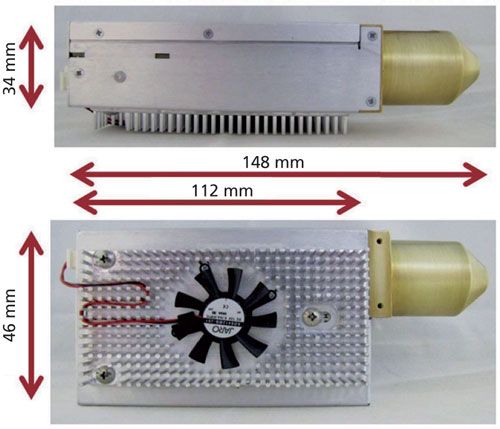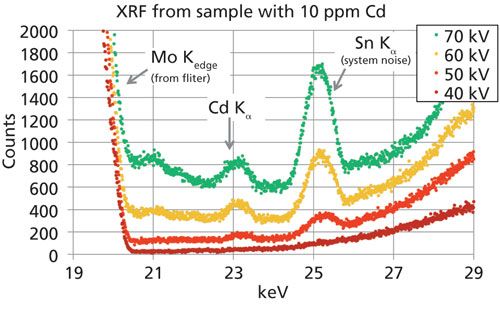Miniature 70 kV, 12W X-ray Source
Recently, the compact MAGPRO’s maximum voltage was increased from 60 kV to 70 kV while maintaining the same size profile. This article highlights the advantages of 70 kV excitation of cadmium, an element of interest for Restriction of Hazardous Substances Directive (RoHS), at parts per million (ppm) levels.
Recently, the compact MAGPRO’s maximum voltage was increased from 60 kV to 70 kV while maintaining the same size profile. This article highlights the advantages of 70 kV excitation of cadmium, an element of interest for Restriction of Hazardous Substances Directive (RoHS), at parts per million (ppm) levels.
The MAGPRO 12 W miniature source is small and low power, which is an advantage for a number of applications. Our 12 W source has several anode materials available; a tungsten anode for either XRF or in X-ray imaging, as well as Rh, Ag, Cr, Cu, and Mo. The entire X-ray source (tube plus high voltage power supply) weights about 700 g (25.0 oz) and can be controlled by your choice of USB, digital, or analog control and has an interlock connection for X-ray safety (Figure 1). The increase of high voltage from 60 kV to 70 kV for the MAGPRO was primarily motivated for use in handheld imaging applications. This increase in voltage also shows important benefits for spectroscopy applications as well. This article highlights the advantages of the 70 kV excitation for low levels of cadmium.
Figure 1: Image of the 12 W X-ray source

Experimental Conditions and Results for XRF Detection of Cadmium
Cadmium detection is of interest because it is a toxic metal that needs to be detected under RoHS/WEEE compliance. Detection of cadmium at low levels is particularly difficult to detect at lower concentrations because cadmium’s 23.2 keV Kα emission line is much higher than other toxic elements of interest. An X-ray source with a higher voltage helps to increase the X-ray signal from cadmium. For this experiment, we used a typical XRF setup where the sample is placed at 45° to the tube and detector. The X-ray spot on the sample was 4x6 mm, achieved with a collimator and a tube-to-sample distance of 25 mm. A 200 μm molybdenum foil was placed between the tube and sample to suppress the Compton background scattering roughly between 20 to 30 keV; thereby suppressing the background under the cadmium Kα peak. Figure 2 shows four spectra taken from a polyvinyl chloride sample with 10 ppm of Cd, with the tube set at 40, 50, 60, and 70 kV. A 42 mm2 SDD collected the data with a 15 mm sample-to-detector distance over 180 s live time, with the input count rate ranging from 20 to 100 kcps. It is evident that increasing the voltage also increases the cadmium signal. In this set-up, 10 ppm of cadmium is detectable in a reasonable 3–5 min time frame.
Figure 2: The cadmium line at about 23.2 keV gets larger as the voltage on the tube is increased. This is an advantage for cadmium detection in XRF systems looking for toxic metal at low concentrations.

Conclusion
The MAGPRO source is meant for use in small benchtop systems where small size is valued. It has increased its high voltage range from 60 kV to 70 kV, which is an advantage in detecting higher atomic number elements such as the hazardous substance cadmium.

Moxtek
452 West 1260 North, Orem, UT 84057
tel. (800) 758-3110
email: info@moxtek.com
Website: www.moxtek.com
